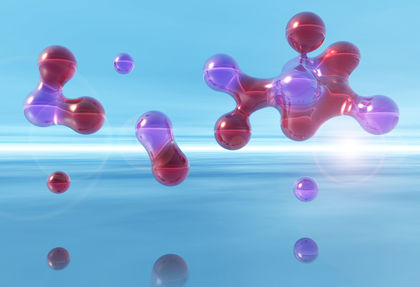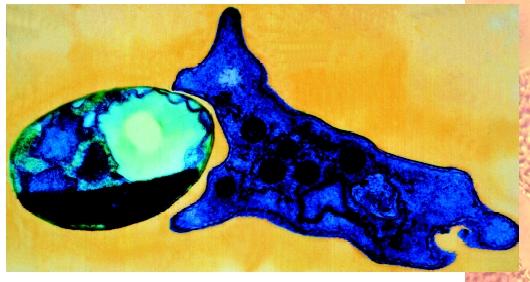Endocytosis

The ability to internalize material from outside the cell is important for several cellular processes including the ingestion of essential nutrients, removal of dead or damaged cells from the body, and defense against microorganisms. Eukaryotic cells internalize fluid, large and small molecules, and even other cells from their surroundings by a process called endocytosis. During endocytosis, the plasma membrane of the cell forms a pocket around the material to be internalized. The pocket closes and then separates from the

There are two main types of endocytosis that are distinguished by the size of the vesicle formed and the cellular machinery involved. Pinocytosis (cell drinking) describes the internalization of extracellular fluid and small macromolecules by means of small vesicles. Phagocytosis (cell eating) describes the ingestion of large particles such as cell debris and whole microorganisms by means of large vesicles. While all eukaryotic cells are continually ingesting fluid and molecules by pinocytosis, only specialized phagocytic cells ingest large particles.
Specialized Phagocytic Cells Engulf Large Particles
Phagocytosis begins with the extension of large, handlike projections from the plasma membrane. The projections surround the particle and fuse together so that the particle is completely engulfed in a large vesicle within the cell called a phagosome. Inside the cell, the phagosome fuses with another membranous organelle called a lysosome, forming a single membranous organelle and mixing their contents in the process. Lysosomes, acting as the "stomach" of the cell, carry digestive enzymes that break down all types of biological molecules. Consequently, after a phagosome fuses with a lysosome, the digestive enzymes break down the ingested material into small molecules that are transported into the cytosol and made available for cell use. Many single-celled organisms like amoebas and ciliates use phagocytosis as a means to acquire food. In multicellular animals, only specialized types of cells use phagocytosis. For example, in humans, specialized white blood cells called macrophages use phagocytosis to defend the body against infection by engulfing invading microorganisms and to remove cell debris from the body by ingesting damaged or old cells.
All Eukaryotic Cells Constantly Ingest Fluid and Molecules by Pinocytosis
In contrast to phagocytosis, pinocytosis begins with small, convex pits on the cell surface that collect material or fluid to be internalized. The convex pits expand into the interior of the cell forming small vesicles that pinch from the inside of the plasma membrane. All eukaryotic cells have a continuous stream of vesicles budding from the plasma membrane. The constant removal of membrane from the plasma membrane would quickly deplete the plasma membrane if not for the balancing effects of another continual process called exocytosis. Exocytosis is the process by which vesicles from inside the cell fuse with the plasma membrane to secrete material and fluid. So, pinocytosis brings fluid and material into the cell and removes membrane from the plasma membrane, while exocytosis expels fluid and mate-rial from the cell while adding membrane to the plasma membrane. Thus, the two processes work together to continuously recycle the plasma membrane.
The most thoroughly understood form of pinocytosis is receptor-mediated endocytosis. Receptor-mediated endocytosis selectively internalizes specific molecules that are found in low concentrations in the extracellular space, such as hormones , growth factors, antibodies, iron, enzymes, vitamins, and cholesterol. The specific molecules to be internalized bind to proteins called receptors on the outside surface of the cell. Receptors are proteins that are embedded in the plasma membrane with portions of the protein extending outside the cell to form a binding site for a specific molecule. Once molecules bind to their receptors, the receptors move within the plasma membrane and become concentrated in small depressions called clathrin-coated pits. Clathrin-coated pits are formed when many clathrin protein molecules interact with each other to form a convex, basketlike structure on the inside of the plasma membrane that molds the membrane into a pit. The coated pits then progressively invaginate, or form inward, to form clathrin-coated vesicles that pinch off the plasma membrane into the cytoplasm . Hence, the clathrin-coated vesicles carry the receptor proteins taken from the plasma membrane and their bound molecules taken from the extracellular space.
Once a clathrin-coated vesicle pinches from the inner surface of the plasma membrane, the clathrin coat is removed. The "uncoated" vesicle, still carrying receptor proteins and their bound cargo molecules, fuses with another membranous organelle called an endosome. Endosomes function as "sorting stations." In an endosome, molecules are sorted and packaged into new vesicles for transportation to various locations within the cell.
Receptors brought into the cell by receptor-mediated endocytosis have one of several fates after unloading their cargo and leaving the endosome: (1) they can be recycled back to the same area of plasma membrane from which they came; (2) they can be transported to another region of the plasma membrane; or (3) they can be transported to the lysosome where they are degraded. Thus, in contrast to phagocytosis, not all material brought into the cell by receptor-mediated endocytosis ends up in the lysosome for digestion.
Endocytosis of Cholesterol
Receptor-mediated endocytosis was discovered by Michael Brown and Joseph Goldstein, who were investigating the internalization of cholesterol by cells from the bloodstream. Brown and Goldstein won the Nobel Prize in medicine in 1985 for their discovery. Cholesterol, a type of lipid , is insoluble and is transported in the bloodstream bound to protein in particles called lowdensity lipoproteins (LDL). The LDL particles bind to LDL receptors on cell surfaces, and the LDL/receptor complexes are concentrated into clathrincoated pits. The clathrin-coated pits develop into clathrin-coated vesicles that move into the interior of the cell, lose their clathrin coats, and fuse with an endosome. The acidic environment of the endosome causes the LDL particles to detach from the LDL receptors, and the two are sorted from each other. The LDL particles are transported to the lysosome where they are broken down by digestive enzymes; the cholesterol is released into the cytosol where it is used in the synthesis of new membrane. The LDL receptors are packaged into membrane vesicles that travel back to and fuse with the plasma membrane (via exocytosis) so that the receptors once again face the exterior of the cell and can pick up more LDL particles to start the cycle again.
SEE ALSO Exocytosis ; Hormones ; Lipids ; Lysosomes ; Membrane Proteins
Cynthia K. Damer and Scott N. Daigle
Bibliography
Aderem, Alan, and David M. Underhill. "Mechanisms of Phagocytosis in Macrophages." Annual Review of Immunology 17 (1999): 593–623.
Alberts, Bruce, et al. Molecular Biology of the Cell, 4th ed. New York: Garland Publishing, 2000.
Mukherjee, Sushmita, Richik N. Ghosh, and Frederick R. Maxfield. "Endocytosis." Physiological Reviews 77 (1997): 759–803.
Schmid, Sandra L. "Clathrin-Coated Vesicle Formation and Protein Sorting: An Integrated Process." Annual Review of Biochemistry 66 (1997): 511–548.
Cristina, Romania